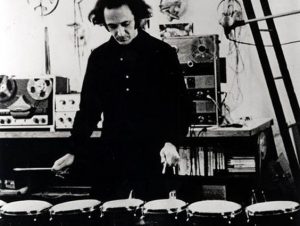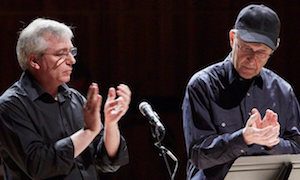This week Classical Music Indy continues to honor Jewish American Heritage Month by taking a look at “the most original musical thinker of our time”1 – Steve Reich. Over the course of his 60 year career, Reich has helped pioneer and develop American Minimalism and Postminimalism through the innovative use of phasing and electronics. Read below about Reich’s life and how his Jewish heritage influenced his work.
Steve Reich: America’s Music Innovator
Steve Reich was born on October 3, 1936 in New York City. His parents divorced when he was only a year old, and he grew up splitting time between New York and California. Reich attended Cornell University, receiving a Bachelor’s Degree in Philosophy with a Minor in Music. After graduation, Reich continued studying composition privately, and even attended Juilliard for three years. He went on to earn his Master’s Degree in Composition from Mills University in Oakland, California in 1963.
A few years after receiving his Master’s, Reich formed his own musical ensemble, “Steve Reich and Musicians,” to perform his original works. Since 1971, the group has toured worldwide performing Reich’s music. He continues to write ground-breaking compositions and has received various awards for his work (including the Pulitzer Prize in Music in 2009 for his piece Double Sextet).

Steve Reich – UC Berkeley University Museum, November 7, 1970
Reich’s early compositional career in the 60s and 70s is best characterized by minimalism and phasing. American Minimalism is a term used to describe music by the likes of Terry Riley, Phillip Glass, John Adams, and Steve Reich. Common features of minimalism include consonant harmony (harmony that pleases the ear), repetition of motives (using the same small fragments repeatedly), and rhythmic pulsation (having a constant, clear and steady beat). Minimalism began as an avant-garde technique, but has since become more mainstream in contemporary classical music.
Phasing is a musical technique mastered by Reich that influenced future generations of composers. In its simplest form, phasing is when two parts of a piece of music begin together playing at the exact same time, but then gradually “phase” out of sync with each other to create a new rhythmic pattern. Examples of minimalism and phasing in Reich’s music can be heard in Piano Phase (1967) and Clapping Music (1972).
In 1976 and 1977 Reich studied traditional cantillation (chanting) of Hebrew scriptures in New York and Jerusalem. This ultimately led to the composition of Tehillim in 1981. Tehillim (meaning “Psalms” in Hebrew) is written for four female vocalists and orchestra. As a large scale orchestral piece and as his first foray into composition influenced by his Jewish heritage, it departs somewhat from the style of Reich’s earlier compositions. The four movements still maintain the pulsating elements associated with minimalism, but with a strong focus on melody.

Steve Reich, right, performs Clapping Music with London Sinfonietta principal percussionist David Hockings.
With another piece, Different Trains, Reich’s style started to shift from minimalism toward postminimalism. Reich wrote the piece for string quartet and tape in 1988 as a reflection on being Jewish in America vs. in Europe during World War II. The idea for the composition came to Reich on a train while contemplating the stark difference between his Jewish upbringing in the US, compared to what it might have been if his parents had lived in Europe at the time of WWII. Different Trains uses a pre-recorded tape with voices from intercoms at train stations and the sounds of trains on railroad tracks. The stark difference between the American and European movements are shown through the string quartet’s mimicry of the rhythms of speech on the different tapes; the American movement is upbeat, while the European movement is reflective of war.
Steve Reich’s influence continues to this day, lauded as one of “a handful of living composers who can legitimately claim to have altered the direction of musical history,”2(The Guardian). In 2016 Reich turned 80, a milestone marked by a bevy of new releases from record labels and musicians. One of these releases (Third Coast Percussion’s Steve Reich), won a Grammy in February 2017, showing his on-going contribution and influence on present day musical culture. Reich’s work combining traditional instruments with electronics, originally avant-garde, has now become widely accepted among classical musicians and audiences from all walks of life.
To listen to the pieces mentioned in this article, see below for a free Spotify Playlist!







Leave a Reply